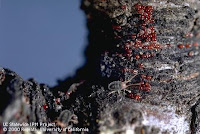Dormant Spray Considerations for Almonds
 |
| Scab lesions on green wood of almond. |
Being one of the quieter times of the year, the dormant period is a prime time to assess orchard issues and begin applying strategies to reduce various diseases and insect pests. Surveying the orchard and sampling new growth and spurs can help identify problems of scab, San Jose Scale, Navel Orange Worm, and mites. If populations are high enough, dormant strategies can be applied to reduce the damage to the upcoming season’s crop.
Scab. If a scab outbreak and the corresponding mid- to late-season defoliation were experienced this past year, a dormant/delayed dormant application of copper and oil should be considered. This spray is effective in reducing and delaying sporulation of scab twig lesions, thus reducing in-season disease incidence. It should be used in combination with properly timed bloom and petal fall sprays. Based on field observations, orchards with significant scab outbreaks in 2010 that followed the above recommendations had obvious suppression of the disease in 2011, and were able to keep the leaves on the trees until late November.
 |
| Red Halos caused by San Jose Scale feeding/infestation in almond. |
Insect Pests. Spur samples should be selected throughout the orchard to determine the presence of San Jose Scale (SJS), European Red Mite (ERM), and Brown Almond Mite (BAM). Spurs should be pulled from a main scaffold with 100 spurs samples from the orchard. If 20% of the spurs selected are infested with scale, then a one-time oil application at 6-8 gallons per acre should be applied. If over 60% of the spurs are infested, the oil application should include an insect growth regulator that targets SJS. It is important to control SJS as high populations can kill spur wood, reducing crop load. Obvious signs of scale infestation include a red halo found on green tissue.
If very little scale is found, but over 20% of the spurs contain eggs of either the ERM or BAM, an oil application at a rate of 4 gallons per acre should still be considered. This application will smother mite eggs, reducing the overwintering population.
 |
| Eggs and adults of the brown almond mite found on an almond spur. |
Another consideration to make is the inclusion of an insect growth regulator such as Dimilin for control of peach twig borer (PTB). Applied with oil during delayed dormant, this is a very effective spray. If there are no other reasons to make a dormant application, sprays targeting PTB can be made in the spring time. The application of broad spectrum insecticides (pyrethroids, organophosphates) should be avoided at this time as they target beneficials that provide control of SJS, ERM, and BAM and are toxic to bees.
Finally, growers of soft shell varieties should do a mummy count of two trees per acre. The average number of mummies found will provide an estimation of navel orange worm (NOW) damage. If there are more than two mummies found per tree, it is recommended that the trees are shaken to reduce the overwintering mummy count to two mummies per tree or less. Sanitation is also recommended on hardshells as NOW has been found to overwinter in the hulls of these varieties.
Taking advantage of the reduced work load during the dormant season to sample the orchard may prove beneficial; if any of the above problems exist, applying the needed corrective measures will help set the stage for a successful growing year. Furthermore, it could save the cost of a trip through the orchard during the winter if pests are not present.
